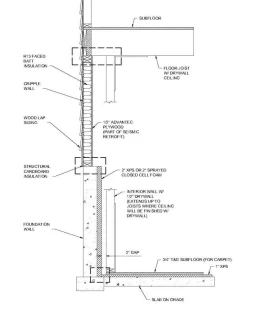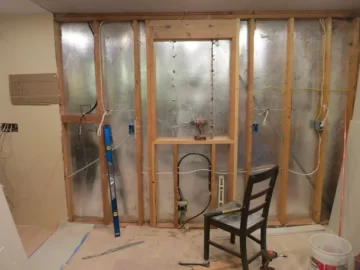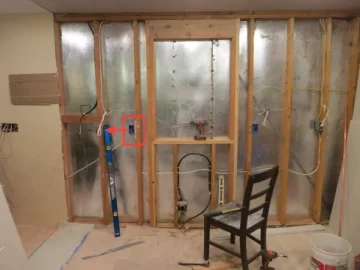in the upcoming months, i will be remodeling our basement. there are two primary goals:
1. seismic retrofit (basically involves anchors bolts, tie down straps, and adding plywood to the interior face of cripple walls)
2. improve insulation
my insulation scheme is as follows:
- 1" XPS on the floor with 3/4" tongue and groove plywood over it (for carpet)
- concrete foundation wall gets 2" of XPS or spray foam (closed cell)
- cripple walls get R13 faced batt insulation
- insulate joist cavities at the rim board as well as general air sealing
please take a look at this image for my plan:

i have several question areas which are indicated by the dark dashed boxes. let's start from the top and work down.
1. at the interface of the joists and the wall, how should i best insulate this? i know you can spray foam or XPS foam the cavity, but i'm curious about transitions to other wall/ceiling surfaces. it seems to me i need to fully cover any potential cold surfaces to prevent cold air from contacting my future finished interior wall.
2. at the transition between cripple wall and concrete foundation wall, what should i do here? i've seen some suggest just putting a vapor barrier over the cripple wall (like 6 mil plastic) and then taping it to the XPS foam (assuming i use XPS and not spray foam). but, that method seems inadequate to me since it feels like that's a good spot for cold air in the winter to come off the concrete, then reach the backside of the interior (heated) wall.
3. where the floor insulation meets the concrete wall insulation. should i leave a gap or make it tight? some say that a gap is good in the event it gets moist. as far as i can tell, we have a pretty dry basement, though there is a musty smell (likely in the floor which i'll be ripping out). no matter what, i plan to hold the subfloor a few inches away from the wall insulation.
bonus question:
on the surface of the interior plywood used for the seismic retrofitting, should i just spray foam or XPS foam over this to create a vapor barrier? this is my biggest concern of the project. i do not want to inadvertently create reverse vapor barriers or not insulate correctly.
i can see moisture/cool air getting in through the cripple wall foundation plate and into the cripple wall (which will have batt insulation). once there, it seems easy enough for it to permeate through gaps and the plywood and then reach the back of the interior (heated) wall. i feel like foaming over the entire wall surface could avoid this potential issue, but then i am worried about doing something stupid like trapping too much moisture in the batt insulation or reversing a vapor barrier. please see the pic below. this kind of "insulation" is underneath my siding. i call it structural cardboard --- it's about 1/8" thick and has a silver facing.

1. seismic retrofit (basically involves anchors bolts, tie down straps, and adding plywood to the interior face of cripple walls)
2. improve insulation
my insulation scheme is as follows:
- 1" XPS on the floor with 3/4" tongue and groove plywood over it (for carpet)
- concrete foundation wall gets 2" of XPS or spray foam (closed cell)
- cripple walls get R13 faced batt insulation
- insulate joist cavities at the rim board as well as general air sealing
please take a look at this image for my plan:

i have several question areas which are indicated by the dark dashed boxes. let's start from the top and work down.
1. at the interface of the joists and the wall, how should i best insulate this? i know you can spray foam or XPS foam the cavity, but i'm curious about transitions to other wall/ceiling surfaces. it seems to me i need to fully cover any potential cold surfaces to prevent cold air from contacting my future finished interior wall.
2. at the transition between cripple wall and concrete foundation wall, what should i do here? i've seen some suggest just putting a vapor barrier over the cripple wall (like 6 mil plastic) and then taping it to the XPS foam (assuming i use XPS and not spray foam). but, that method seems inadequate to me since it feels like that's a good spot for cold air in the winter to come off the concrete, then reach the backside of the interior (heated) wall.
3. where the floor insulation meets the concrete wall insulation. should i leave a gap or make it tight? some say that a gap is good in the event it gets moist. as far as i can tell, we have a pretty dry basement, though there is a musty smell (likely in the floor which i'll be ripping out). no matter what, i plan to hold the subfloor a few inches away from the wall insulation.
bonus question:
on the surface of the interior plywood used for the seismic retrofitting, should i just spray foam or XPS foam over this to create a vapor barrier? this is my biggest concern of the project. i do not want to inadvertently create reverse vapor barriers or not insulate correctly.
i can see moisture/cool air getting in through the cripple wall foundation plate and into the cripple wall (which will have batt insulation). once there, it seems easy enough for it to permeate through gaps and the plywood and then reach the back of the interior (heated) wall. i feel like foaming over the entire wall surface could avoid this potential issue, but then i am worried about doing something stupid like trapping too much moisture in the batt insulation or reversing a vapor barrier. please see the pic below. this kind of "insulation" is underneath my siding. i call it structural cardboard --- it's about 1/8" thick and has a silver facing.




